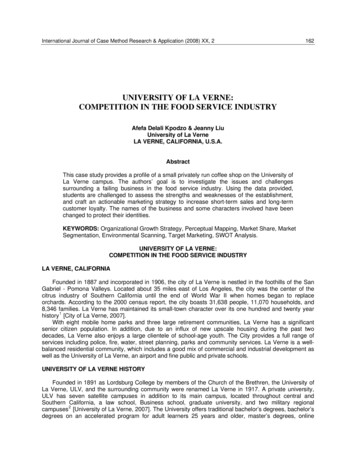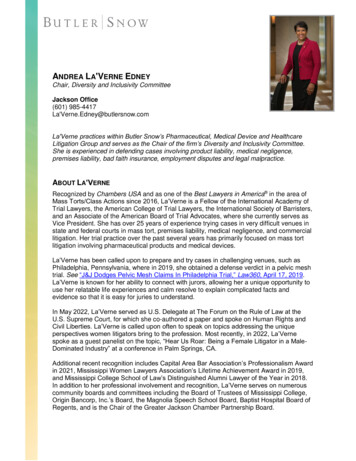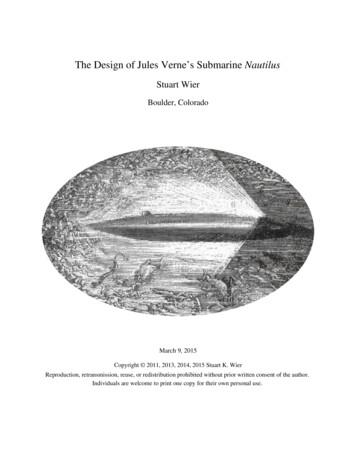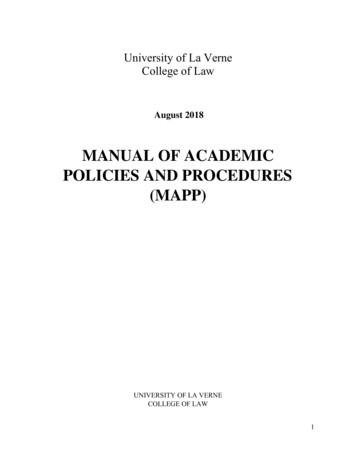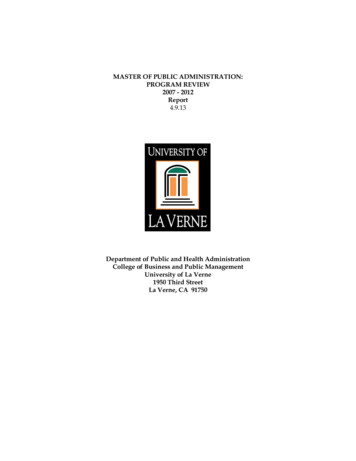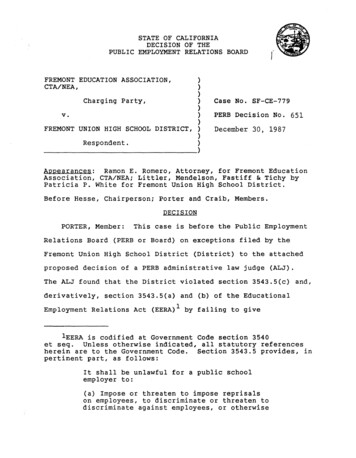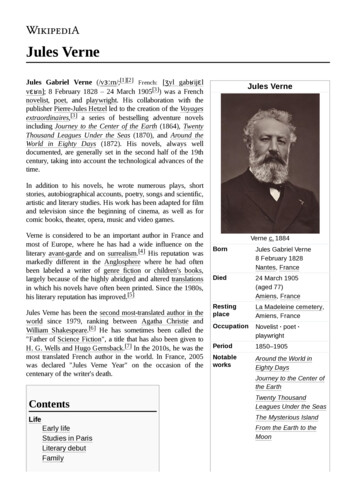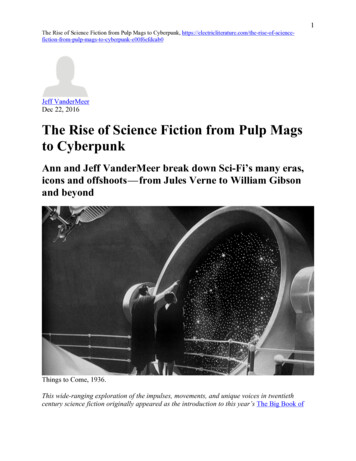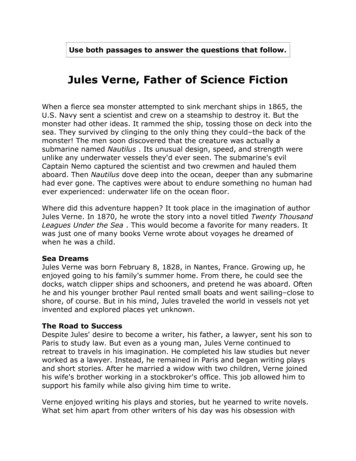
Transcription
Use both passages to answer the questions that follow.Jules Verne, Father of Science FictionWhen a fierce sea monster attempted to sink merchant ships in 1865, theU.S. Navy sent a scientist and crew on a steamship to destroy it. But themonster had other ideas. It rammed the ship, tossing those on deck into thesea. They survived by clinging to the only thing they could–the back of themonster! The men soon discovered that the creature was actually asubmarine named Nautilus . Its unusual design, speed, and strength wereunlike any underwater vessels they'd ever seen. The submarine's evilCaptain Nemo captured the scientist and two crewmen and hauled themaboard. Then Nautilus dove deep into the ocean, deeper than any submarinehad ever gone. The captives were about to endure something no human hadever experienced: underwater life on the ocean floor.Where did this adventure happen? It took place in the imagination of authorJules Verne. In 1870, he wrote the story into a novel titled Twenty ThousandLeagues Under the Sea . This would become a favorite for many readers. Itwas just one of many books Verne wrote about voyages he dreamed ofwhen he was a child.Sea DreamsJules Verne was born February 8, 1828, in Nantes, France. Growing up, heenjoyed going to his family's summer home. From there, he could see thedocks, watch clipper ships and schooners, and pretend he was aboard. Oftenhe and his younger brother Paul rented small boats and went sailing–close toshore, of course. But in his mind, Jules traveled the world in vessels not yetinvented and explored places yet unknown.The Road to SuccessDespite Jules' desire to become a writer, his father, a lawyer, sent his son toParis to study law. But even as a young man, Jules Verne continued toretreat to travels in his imagination. He completed his law studies but neverworked as a lawyer. Instead, he remained in Paris and began writing playsand short stories. After he married a widow with two children, Verne joinedhis wife's brother working in a stockbroker's office. This job allowed him tosupport his family while also giving him time to write.Verne enjoyed writing his plays and stories, but he yearned to write novels.What set him apart from other writers of his day was his obsession with
travel to places never explored: the bottom of the ocean, the middle of theearth, and outer space! Although not a scientist, he read about all kinds ofsciences and had many discussions with scientist friends. The knowledge hegleaned enabled him to picture worlds and technology that might becomepossible in the future. His first novel, Five Weeks in a Balloon , toldadventures of people floating over Africa in a balloon. This type of voyagehad never been undertaken when the book was released in 1863. Since thattime, of course, balloonists have taken even longer trips over severalcontinents.A New Type of FictionHis first novel was so successful that Verne was able to leave his job andwrite full time. It took two years to transfer his futuristic undersea adventurefrom his imagination to paper. He didn't know that he was creating a newtype of literature that would become a favorite of readers around the world:science fiction. He had no way of knowing that the futuristic technology hebuilt into Nautilus , such as scuba gear and the ability to create anunderwater habitat where humans could comfortably live surrounded byocean creatures, would one day become reality. Up until his death in 1905,Verne had only one goal: to entertain readers everywhere with his fantastictravels.A Trip to Inner Space: Jules' Undersea LodgeYou awake and sit up in bed. You feel uneasy. Someone or something iswatching you. Then you see them. Dozens of fish of every color and speciesare peering at you through your window. No, you're not dreaming. You'vejust spent a night in Jules' Undersea Lodge, the world's first underwaterhotel. It opened in 1986 in Key Largo, Florida.Today there are many underwater hotels. But travel experts still considerJules' Undersea Lodge to be one of the top five in the world.BeginningsJules' Undersea Lodge began as an undersea research lab off the coast ofPuerto Rico. Scientist Ian Koblick designed it in the 1970s. At that time,underwater travel and habitats were mainly of interest to scientists. Butsoon, people around the world took an interest in ecology. They wondered ifhumans could live in other environments, such as under the sea or on themoon.
Koblick and another scientist, Dr. Neil Monney, had an idea. They wantedordinary people to experience the wonders of life in the ocean. So theymoved the undersea research lab to the Emerald Lagoon in Key Largo.Together, they remodeled the lab into an underwater hotel. They named it"Jules' Undersea Lodge" to honor French author Jules Verne. In 1863, hisnovel Twenty Thousand Leagues Under the Sea foretold the type ofundersea living that today is possible for humans.Hotel on StiltsThere's only one way to enter Jules' Undersea Lodge. Guests must scubadive to the entrance! It is located twenty-one feet below the sea. That isabout as deep as a two-story building. Hotel staff supplies the diving gearand accompanies guests to the lodge, carrying their suitcases in waterproofbags.If you're among those guests, you'll line up on the lagoon floor beneathJules' Undersea Lodge. It stands on five-foot stilts. Unlike walking into theHoliday Inn through a door, you will push up and enter through the "moonpool" entrance on the floor. The hotel is filled with compressed air, which isheavier than water. Therefore, the sea will remain outside and will not floodthe inner space you have entered.Jules' Undersea Lodge can only accommodate up to six people at a time.Near the entrance is a "wet room" where you can shed your scuba gear andtake a shower. Then you're ready to go into one of the two bedrooms. Eachhas its own bathroom. Or perhaps you'd rather go first into the "commonroom." There you'll find a refrigerator and microwave oven. In anothercorner you can find a television and VCR/DVD player. The hotel staffprovides snacks, or you can bring and cook your own food. If you'd rathernot cook, arrange with the hotel to have a pizza delivered. A scuba diverdelivery person brings it to you–in a waterproof box, of course!Although you can stay in the hotel and watch the fish watching you, thereare other things to do as well. Some of these are: scuba diving and exploring the underwater life of the Emerald Lagoon swimming to and visiting nearby MarineLab, an undersea research labalso designed and run by Koblick and Monney grabbing an underwater flashlight and going night diving bringing your underwater camera on a diving excursion andphotographing those fish that have been spying on you
taking some of the courses offered by the hotel on undersea habitatsand exploration learning basic and advanced scuba diving skillsPeople are begging for more hotels like Jules' Undersea Lodge. Developersaround the world are planning for even bigger underwater habitats. "To livebeneath the sea was once just the dream of science fiction writers," says Dr.Monney. "Now it is a reality. Here is a new step for mankind, the advent ofundersea living, the taming of the last frontier on Earth. Inner Space."STANDARD: 5.RI.2This task has more than one (1) part. Read each part carefully and respond.Part AHow does Jules' Undersea Lodge reflect ideas that Verne wrote about in hisnovel Twenty Thousand Leagues Under the Sea ? Explain using details fromboth "Jules Verne, Father of Science Fiction" and "A Trip to Inner Space."Part BUsing details from both articles, explain how the experiences of the guests ofJules' Undersea Lodge would be similar to those of the characters in TwentyThousand Leagues Under the Sea . How would today's guest experiences bedifferent ?Be sure to complete ALL parts of the task.Use details from the text to support your answer.Answer with complete sentences, and use correct punctuation andgrammar.
Rubric:Below is a generic rubric. To view a detailed item-specific rubric for scoring this item,click 'View Sample Paper' above. You will also see annotated student monstratedThe student demonstrates a thorough understanding ofthe standards assessed.3ClearlyDemonstratedThe student demonstrates a clear understanding of thestandards assessed.2BasicallyDemonstratedThe student demonstrates a basic understanding of thestandards assessed.1MinimallyDemonstratedThe student demonstrates a minimal understanding ofthe standards assessed.0Incorrect orIrrelevantThe response is incorrect or irrelevant.
Control Number: FD-00133Version 2This document is electronically version controlled.Verify printed document is the current version before use.Georgia Benchmarking2014Grade 05Form 14EL14PT0500811405010Jules Verne, Father of Science Fiction / ATrip to Inner SpaceAnchor SetDate5/12/14Pearson – Internal Use and Distribution OnlyCommentsProposed Anchor SetVersion1Page 1 of 33
Use both passages to answer the questions that follow.Jules Verne, Father of Science FictionWhen a fierce sea monster attempted to sink merchant ships in 1865, the U.S. Navy sent a scientistand crew on a steamship to destroy it. But the monster had other ideas. It rammed the ship, tossingthose on deck into the sea. They survived by clinging to the only thing they could—the back of themonster! The men soon discovered that the creature was actually a submarine named Nautilus. Itsunusual design, speed, and strength were unlike any underwater vessels they’d ever seen. Thesubmarine’s evil Captain Nemo captured the scientist and two crewmen and hauled them aboard.Then Nautilus dove deep into the ocean, deeper than any submarine had ever gone. The captiveswere about to endure something no human had ever experienced: underwater life on the ocean floor.Where did this adventure happen? It took place in the imagination of author Jules Verne. In 1870, hewrote the story into a novel titled Twenty Thousand Leagues Under the Sea. This would become afavorite for many readers. It was just one of many books Verne wrote about voyages he dreamed ofwhen he was a child.Sea DreamsJules Verne was born February 8, 1828, in Nantes, France. Growing up, he enjoyed going to hisfamily’s summer home. From there, he could see the docks, watch clipper ships and schooners, andpretend he was aboard. Often he and his younger brother Paul rented small boats and went sailing—close to shore, of course. But in his mind, Jules traveled the world in vessels not yet invented andexplored places yet unknown.The Road to SuccessDespite Jules’ desire to become a writer, his father, a lawyer, sent his son to Paris to study law. Buteven as a young man, Jules Verne continued to retreat to travels in his imagination. He completed hislaw studies but never worked as a lawyer. Instead, he remained in Paris and began writing plays andshort stories. After he married a widow with two children, Verne joined his wife’s brother workingin a stockbroker’s office. This job allowed him to support his family while also giving him time towrite.Verne enjoyed writing his plays and stories, but he yearned to write novels. What set him apart fromother writers of his day was his obsession with travel to places never explored: the bottom of theocean, the middle of the earth, and outer space! Although not a scientist, he read about all kinds ofsciences and had many discussions with scientist friends. The knowledge he gleaned enabled him topicture worlds and technology that might become possible in the future. His first novel, Five Weeksin a Balloon, told adventures of people floating over Africa in a balloon. This type of voyage hadnever been undertaken when the book was released in 1863. Since that time, of course, balloonistshave taken even longer trips over several continents.A New Type of FictionHis first novel was so successful that Verne was able to leave his job and write full time. It took twoyears to transfer his futuristic undersea adventure from his imagination to paper. He didn’t know thathe was creating a new type of literature that would become a favorite of readers around the world:science fiction. He had no way of knowing that the futuristic technology he built into Nautilus, suchas scuba gear and the ability to create an underwater habitat where humans could comfortably live
surrounded by ocean creatures, would one day become reality. Up until his death in 1905, Verne hadonly one goal: to entertain readers everywhere with his fantastic travels.A Trip to Inner Space: Jules’ Undersea LodgeYou awake and sit up in bed. You feel uneasy. Someone or something is watching you. Then you seethem. Dozens of fish of every color and species are peering at you through your window. No, you’renot dreaming. You’ve just spent a night in Jules’ Undersea Lodge, the world’s first underwater hotel.It opened in 1986 in Key Largo, Florida.Today there are many underwater hotels. But travel experts still consider Jules’ Undersea Lodge tobe one of the top five in the world.BeginningsJules’ Undersea Lodge began as an undersea research lab off the coast of Puerto Rico. Scientist IanKoblick designed it in the 1970s. At that time, underwater travel and habitats were mainly of interestto scientists. But soon, people around the world took an interest in ecology. They wondered ifhumans could live in other environments, such as under the sea or on the moon.Koblick and another scientist, Dr. Neil Monney, had an idea. They wanted ordinary people toexperience the wonders of life in the ocean. So they moved the undersea research lab to the EmeraldLagoon in Key Largo. Together, they remodeled the lab into an underwater hotel. They named it“Jules’ Undersea Lodge” to honor French author Jules Verne. In 1863, his novel Twenty ThousandLeagues Under the Sea foretold the type of undersea living that today is possible for humans.Hotel on StiltsThere’s only one way to enter Jules’ Undersea Lodge. Guests must scuba dive to the entrance! It islocated twenty-one feet below the sea. That is about as deep as a two-story building. Hotel staffsupplies the diving gear and accompanies guests to the lodge, carrying their suitcases in waterproofbags.If you’re among those guests, you’ll line up on the lagoon floor beneath Jules’ Undersea Lodge. Itstands on five-foot stilts. Unlike walking into the Holiday Inn through a door, you will push up andenter through the “moon pool” entrance on the floor. The hotel is filled with compressed air, whichis heavier than water. Therefore, the sea will remain outside and will not flood the inner space youhave entered.Jules’ Undersea Lodge can only accommodate up to six people at a time. Near the entrance is a “wetroom” where you can shed your scuba gear and take a shower. Then you’re ready to go into one ofthe two bedrooms. Each has its own bathroom. Or perhaps you’d rather go first into the “commonroom.” There you’ll find a refrigerator and microwave oven. In another corner you can find atelevision and VCR/DVD player. The hotel staff provides snacks, or you can bring and cook yourown food. If you’d rather not cook, arrange with the hotel to have a pizza delivered. A scuba diverdelivery person brings it to you—in a waterproof box, of course!Although you can stay in the hotel and watch the fish watching you, there are other things to do aswell. Some of these are:
scuba diving and exploring the underwater life of the Emerald Lagoonswimming to and visiting nearby MarineLab, an undersea research lab also designed and runby Koblick and Monneygrabbing an underwater flashlight and going night divingbringing your underwater camera on a diving excursion and photographing those fish thathave been spying on youtaking some of the courses offered by the hotel on undersea habitats and explorationlearning basic and advanced scuba diving skillsPeople are begging for more hotels like Jules’ Undersea Lodge. Developers around the world areplanning for even bigger underwater habitats. “To live beneath the sea was once just the dream ofscience fiction writers,” says Dr. Monney. “Now it is a reality. Here is a new step for mankind, theadvent of undersea living, the taming of the last frontier on Earth . . . Inner Space.”STEM:This task has more than one (1) part. Read each part carefully and respond.Part AHow does Jules’ Undersea Lodge reflect ideas that Verne wrote about in his novelTwenty Thousand Leagues Under the Sea? Explain using details from both “JulesVerne, Father of Science Fiction” and “A Trip to Inner Space.”Part BUsing details from both articles, explain how the experiences of the guests of Jules’Undersea Lodge would be similar to those of the characters in Twenty ThousandLeagues Under the Sea. How would today’s guest experiences be different?Be sure to complete ALL parts of the task.Use details from the text to support your answer.Answer with complete sentences, and use correct punctuation and grammar.
onstrated0Incorrect orirrelevantDescriptionIn Part A, the student thoroughly describes how Jules’ UnderseaLodge reflects ideas that Verne wrote about in his novel TwentyThousand Leagues Under the Sea and explains using details fromboth articles. In Part B, the student uses details to thoroughlyexplain how experiences of the guests of Jules’ Undersea Lodgewould be similar to those of the characters in Twenty ThousandLeagues Under the Sea. The student also thoroughly explainshow today’s guest experiences would be different. The responsemust demonstrate a thorough common of the conventions ofstandard English. Though there may be a few minor errors ingrammar and usage, meaning is clear throughout the response.In Part A, the student describes how Jules’ Undersea Lodgereflects ideas that Verne wrote about in his novel TwentyThousand Leagues Under the Sea and explains using details fromboth articles. In Part B, the student uses details to explain howexperiences of the guests of Jules’ Undersea Lodge would besimilar to those of the characters in Twenty Thousand LeaguesUnder the Sea. The student also explains how today’s guestexperiences would be different. The response must demonstratea command of the conventions of standard English. There may bea few distracting errors in grammar and usage, but meaning isclear.In Part A, the student basically describes how Jules’ UnderseaLodge reflects ideas that Verne wrote about in his novel TwentyThousand Leagues Under the Sea and includes a detail from atleast one article. In Part B, the student uses details to basicallyexplain how experiences of the guests of Jules’ Undersea Lodgewould be similar to those of the characters in Twenty ThousandLeagues Under the Sea. The student also basically explains howtoday’s guest experiences would be different, using minimalsupport from the text; some support may be incorrect orirrelevant. The response may demonstrate an inconsistentcommand of the conventions of standard English. There are a fewpatterns of errors in grammar and usage that may occasionallyimpede understanding.In Part A, the student mentions both Jules’ Undersea Lodge andthe novel Twenty Thousand Leagues Under the Sea providingminimal details. In Part B, the student tells that guest experiencesmight be similar and/or different from the characters’experiences, but uses no details from the text for support. Theresponse may demonstrate limited command of the conventionsof standard English. There are multiple distracting errors ingrammar and usage that impede understanding.The student response is incorrect or irrelevant.
A1ExemplarPart AJules’ Undersea Lodge reflects some important ideas from the novel Twenty Thousand LeaguesUnder the Sea. In the novel, sailors are captured and taken onto a submarine, where they livedeep under the ocean and experience many forms of undersea life. In the hotel, guests alsoexperience life under the sea. The idea behind both (learning what it’s like to live under the sea)is the same.Part BGuest experiences in the hotel would be similar to the sailor’s experiences. They watch fish andother sea creatures swim past windows just like the sailors on the submarine in the novel did, andthey are unable to leave the environment without swimming through the ocean. They would relyon technology to provide them with air to breathe and to communicate with the world above theocean surface. There would be differences, too. Guests at the lodge are just that—guests. Theychoose to be there and can leave whenever they want to. The sailors were captives on thesubmarine and were not allowed to leave, so the way they felt about their experience wasprobably very different because of that.In Part A, the student thoroughly describes how Jules’ Undersea Lodge reflects ideas thatVerne wrote about in his novel Twenty Thousand Leagues Under the Sea and explains usingdetails from both articles (The idea behind both [learning what it’s like to live under the sea]is the same). In Part B, the student uses details to thoroughly explain how experiences of theguests of Jules’ Undersea Lodge would be similar to those of the characters in TwentyThousand Leagues Under the Sea (They watch fish and other sea creatures swim). Thestudent also thoroughly explains how guests’ experiences would be different (Guests are thelodge are just that—guests. . . . The sailors were captives on the submarine). The responsecontains no errors in grammar or usage, demonstrating a thorough common of theconventions of standard English. Answering both parts fully, the response earns a score of 4.Score 4
A21846561052Part A Jules Verne wrote a book, Twenty Thousand Leagues Under The Sea,which told of 2 men being captured and put on the Nautlius.The people whohad created the submarine lived there and explored the water, collecteditems, and looked at fish.Jule's Undersea Lodge lets people "live" under thesea for a period of time where they can look at fish, collect things, andexperience what it;s like to live under the ocean.Part B The guest experiences would of been similar because they both can seewonders that you cannot see for a long period of time above water. but belowit. Both people in the lodge and submarine are to feel like this is somethingyou've might of seen in an aquarium. The experiences of the guests aredifferent because the people who go to the lodge come there because theywant to. They also have freedom to go in and out as they please out of theylodge. In the book, the men who have boarded the sub were captured byforce and cannot live unless they are allowed to. They try many escape plans,but all fail. When they are not trying to escape though, it is fun exploring theocean floor and marveling at the colorful with and sea creature through thewindows.In Part A, the student describes how Jules’ Undersea Lodge reflects ideas that Verne wroteabout in his novel Twenty Thousand Leagues Under the Sea and explains using details fromboth articles (The people who had created the submarine lived there and explored the water,collected items, and look at fish. Jule’s Undersea Lodge lets people “live” under the sea for aperiod of time where they can look at fish, collect things, and experience what it;s like to liveunder the ocean). In Part B, the student thoroughly explains how experiences of the guests ofJules’ Undersea Lodge would be similar to (. . . they both can see wonders that you cannotsee for a long period of time above water) and different from (They also have freedom to goin and out as they please our of they lodge. In the book, the men who have boarded the subwere captured by force and cannot live unless they are allowed to) those of the characters inTwenty Thousand Leagues Under the Sea. The response demonstrates a command of theconventions of standard English. The student thoroughly compares the characters to theguests which results in a score of 4.Score 4
A31166561052Part AJules' Undersea Lodge reflects the ideas in Twenty Thousand Leagues Underthe sea because both the book and the lodge explain inhabitants under theocean. The evil captain from the Nautilus captured the scientist and two othercrew members. In his submarine he drove them down to the ocean floor tolife underwater("Jules Verne, Father of Science Fiction"). Now people can liveunder the sea. There is an underwater hotel in Emerald Lagoon that guestshave to scuba dive to in order to get there. In the hotel you can enjoy lifeunder the water("A Trip To Inner Space").Part BThe characters in Jules novel Twenty Leagues Below the Sea and the guests ofJules' Undersea Lodge both experience life underwater. The guest at theLodge have time to enjoy the fish and they are not held captive on asubmarine. The guests also get the chance to swim with the fish and go onunderwater tours. The guests in the lodge enjoy there underwater time betterthan the men on the submarine.In Part A, the student describes how Jules’ Undersea Lodge reflects ideas that Verne wroteabout in his novel Twenty Thousand Leagues Under the Sea and explains using details fromboth articles (. . . both the book and the lodge explain inhabitants under the ocean. . . . In hissubmarine he drove them down to the ocean floor to life underwater . . . . There is anunderwater hotel in Emerald Lagoon that guests have to scuba dive to in order to get there).In Part B, the student explains how experiences of the guests of Jules’ Undersea Lodge wouldbe similar to those of the characters in Twenty Thousand Leagues Under the Sea (. . . bothexperience life underwater). The student also explains how today’s guest experiences wouldbe different (The guest at the Lodge have time to enjoy the fish and they are not held captiveon a submarine). The response demonstrates a command of the conventions of standardEnglish. There are a few errors in the formatting of the titles of the articles and usage (therefor their), but meaning is clear. A lack of specific detail from the text to support thecomparison between the characters and the guests make this response a low score point 3.Score 3
A41206561052Part AIn Twenty Thousand Leagues Under the Sea Jules Verne talked abouttechnology that seemed impossible at the time. He also explained a habitathumans could survive and thrive in underwater. In Jules' Undersea Lodge allof these things are possible. Air protected entrance, Scuba diving to theentrance, and living underwater.Part BIn Twenty Thousand Leagues Under the Sea the characters have thetechnology to live comfortably underwater. In Jules' Undersea Lodge theyhave the technology to live in luxury underwater. In the story however, theprisoners don't enjoy as much luxury as the visitors going to the lodge andthey are in a moving submarine. Finally today's guests could order pizza, goscuba diving , and watch movies in an undersea hotel, but the characterscan't do that.In Part A, the student basically describes how Jules’ Undersea Lodge reflects ideas that Vernewrote about in his novel Twenty Thousand Leagues Under the Sea and includes details fromone of the articles (In twenty Thousand Leagues Under the Sea Jules Verne talked abouttechnology that seemed impossible at the time. In Jules’ Undersea Lodge all of these thingsare possible. Air protected entrance, Scuba diving to the entrance, and living underwater). InPart B, the student basically explains how experiences of the guests of Jules’ Undersea Lodgewould be similar to those of the characters in Twenty Thousand Leagues Under the Sea (. . .have the technology to live comfortably underwater). The student also clearly explains howtoday’s guest experiences would be different, using specific support from the texts (prisonersdon’t enjoy much luxury . . . . Finally today’s guests could order pizza, go scuba diving , andwatch movies in an undersea hotel, but the characters can’t do that). The responsedemonstrates an inconsistent command of the conventions of standard English. There is asentence fragment as well as a pattern of errors in punctuation (In Twenty Thousand LeaguesUnder the Sea[,] Jules Vern talke about echnology . . . . In Jules’ Undersea Lodge[,] all ofthese things are possible). Despite the specific details used to show the differences, theweakness of answer for the similarities makes this a high 2 level response.Score 2
A51056561052part A:It reflects on the ideas he wrote in his books because his book TwentyThousand Leagues is related to the sea as well as the hotel.The book he wroteis about people who were caught by a submarine and would have to liveunder water for the rest of their lives and with the hotel it is sort of the samething you will live under water for just a few days.It is related to A Trip ToInner Space because it is like something very different for you just like thehotel.Part B: The experiences would be similar to the character and the guest at thehotel because they are surrounded by fish and water and they will both stayunder water but the guest at the hotel will only stay there for a little while butthe characters will have to stay there for their whole life.The experienceswould be different because the characters are trap or captured and would notbe able to get out. For the guest they can do whatever they want becausethey just went there for vacation.In Part A, the student basically describes how Jules’ Undersea Lodge reflects ideas that Vernewrote about in his novel Twenty Thousand Leagues Under the Sea and includes a detail fromone article (The book he wrote is about people who were caught by a submarine and wouldhave to live under water for the rest of their lives and with the hotel it is sort of the same thingyou will live under water for just a few days). The information about the hotel is too general.In Part B, the student basically explains how experiences of the guests of Jules’ UnderseaLodge would be similar (. . . they are surrounded by fish and
Jules Verne. In 1870, he wrote the story into a novel titled Twenty Thousand Leagues Under the Sea. This would become a favorite for many readers. It was just one of many books Verne wrote about voyages he dreamed of when he was a child. Sea Dreams Jules Verne was born February 8, 1828, in Nantes, France. Growing up, he
